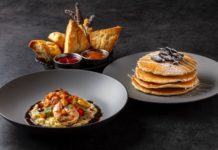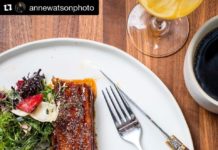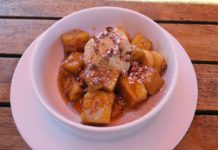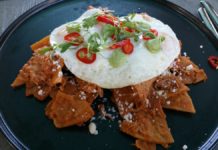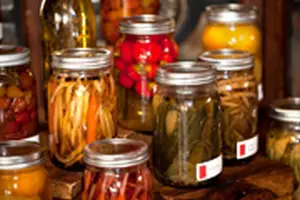“Pickling began 4,000 years ago using cucumbers native to India and it was 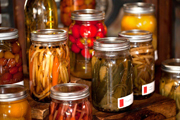 used as a way to preserve food for out-of-season use and for long journeys, especially by sea when you never knew how long you could be out. Now, we eat pickled items because we love the taste,” says Chef Marissa Gerlach of Raya at The Ritz-Carlton, Laguna Niguel.
used as a way to preserve food for out-of-season use and for long journeys, especially by sea when you never knew how long you could be out. Now, we eat pickled items because we love the taste,” says Chef Marissa Gerlach of Raya at The Ritz-Carlton, Laguna Niguel.
Sauerkraut, kimchi, relish, chutney and chow-chow represent just some of the traditional kinds of pickled goods. “Most cultures started to pickle in order to preserve. You can find pickled veggies in all cuisines,” says Michael Stebner. Like many others, the True Food Kitchen brand chef makes pickled onions, zucchini and peppers as well as most of the condiments served in the restaurants.
Salty, sour, sweet and tangy in any combination add tang and zest to sandwiches, soups, salads and entrees. This humble staple has made its way onto a wide range of restaurant menus including fine dining. Chefs have added pickling to their repertoire of techniques and are giving unique spins to their house made versions. Chef/caterer Phil Knoke of Culinary Entertainment notes, “Recently it’s been brought back and expanded on with all the chefs doing more of a creative fusion and finding ways to make pickled food fit in to just about anything,”
“Almost every dish in RAYA has something pickled because it creates a balance in flavors of the food. I am a firm believer in sweet/salty/bitterness/sour and umami. The pickled items add just enough acid. I also love it because it intensifies the flavor of the ingredient and texture,” Gerlach shares. “In RAYA, we use many different pickled onions such as red, white and wild leeks (like ramps to green garlic). We also pickle chilies. But wait, it gets better than that. After we pickle the chilies, we tempura them,” Gerlach shares. Some of the items Gerlach serves with pickled veggies include Smoked Pacific Swordfish Dip-pickled jalapenos, Vintage Natural NY Sirloin-grilled pickled onions, and Black Bass-tempura pickled chilies.
The Matador’s Chef David Dennis pickles onions, carrots and chilies, “I put pickled onions on our steak and on our steak salad; the chilies and carrots usually as a garnish. It just gives the food a contrast of flavor.” Dennis makes all the salsas in house along with chutney, mustard and different ketchups. “It takes food to the next level, and it’s always better homemade.”
Deborah Schneider, executive chef at SOL Cocina – Newport Beach in Newport Beach, is only pickling jalapenos right now. “The pickled jalapeno is a palate cleanser – bites between bites.” Her jalapenos are made unique by the addition of tequila to the pickling mixture. “I want to pickle a bunch more different kinds for our new location coming to Scottsdale vegetables like cauliflower, carrot, chayote, and little sweet peppers. Pickled garlic is pretty awesome too.”
At La Quinta Resort near Palm Springs, Chef Michael Vaughn runs the kitchen at TWENTY6, the hotel’s all day dining facility. “Currently we are pickling cucumbers and purple cauliflower,” he says. “Pickled vegetables are a refreshing way to begin a meal and also serve as a great way to cleanse the palate for the flavors to come.” The house made pickles are served with burgers and sandwiches and the cauliflower arrives as a complimentary first bite when guests are seated.
An avid pickle-maker, Vaughn also pickles green beans, baby carrots, okra, radishes, cherry peppers, tear-drop tomatoes and crosnes* in season. The jars add a colorful visual to the restaurant’s interior. Vaughn shares, “The pickled vegetables add zest, flavor, color, texture and a bit of excitement to the dishes that they accompany. The house made pickles have a beautiful bright and fresh color to them, as well as a tremendous “crunch” that can be heard while enjoying.”
“Made from scratch” is embedded in Chef Vaughn’s culinary DNA. Most of his condiments come from the kitchen instead of jars. Examples include blueberry sauce for hotcakes, ranchero sauce with huevos rancheros, and Californian Gilberto Benedict Secret Sauce on burgers, beef and crab sliders, and corned beef sandwich. A Hot Wing Sauce in development will join the ketchup, BBQ and steak sauce. “We also make all of our dressings, vinaigrettes, salsas and infuse our own special blend of maple syrup with Tahitian vanilla bean and Jack Daniels whiskey.”
Vaughn prefers pickling his own in order to have total control of the outcome, and it gives him room to experiment. “Sourcing quality, fresh, environmentally responsible ingredients; choice of method of preparation; seasoning to maximize flavors; and vessel for presentation,” allow him to create a superior product. In addition, he learns more about the ingredients and finds it helps to sharpen his techniques. “The creative process is challenging and rewarding what works well together and what doesn’t? Should I add a little more or less of this or that?”
Paprika is Chef Vaughn’s favorite spice, “I’m fond of the interesting, deep rich flavor that it imparts to dishes. And I like that the color is bright red when used in its raw form and a deep red when roasted.”
Caterer Phil Knoke, “OC’s Rock N Roll Chef,” creates and executes events all over the county with his company Culinary Entertainment. For the most part he’s a do-it-yourselfer; pickling peppers, red onions, cucumbers, carrots and baby portabellas. He also makes his own salsas, chutneys, BBQ sauces, dressings, specialty mustards and steak sauces. “I can make them exactly the way I taste the flavors together in my head,” he explains, but “Sometimes someone has come out with a product that is so good it’s not worth it to try and come up with your own version. The dish will just taste better with the store bought.”
Lazy Dog Cafe Chef Gabriel Caliendo advocates giving the traditional preserving process a try. “It’s easy and rewarding. And the vegetables last forever.”
The Savory Spice Shop sells and ships spices and seasonings through their Corona del Mar locations and website, www.savoryspiceshop.com. Their Pickling Spice is a blend of cracked Saigon cinnamon, Lampong peppercorns, brown and yellow mustard seeds, cracked ginger, coriander, dill, blade mace, allspice berries, juniper berries, cloves, Pico de Pajaro chilies and cracked bay leaves.
The site also includes easy recipes. To make a salt brine, mix 8 cups of water with a 1/3 cup salt and a 1/2 cup vinegar, enough brine for 2 quarts. The recipe for any vegetable is 2 teaspoons pickling blend per quart of brine. When pickling, be sure that the vegetables are completely submerged in the brine.
Chef Micah Wexler of Mezze in West Hollywood shared his recipe for pickled salmon made with Skuna Bay Salmon. “Pickled salmon is an old school Jewish technique. It is sort of a lost art that a lot of people don’t know about and have never tried. That dish is my homage to the classic,” he says.
* Crosne, pronounced “crone”, is a root vegetable with a nutty sweetness reminiscent of jicama or Jerusalem artichoke.

